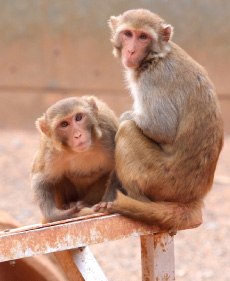A first in monkey models

Yerkes researchers hope the first model of Huntington's in monkeys will provide insights into the disease that causes loss of speech, movement, and swallowing. |
by Quinn Eastman
After creating the first model of a human neurodegenerative disease in rhesus monkeys, Anthony Chan and his colleagues at the Yerkes National Primate Research Center and Emory's Department of Human Genetics are thinking hard about where to go next with their powerful transgenic technology.
Last spring, Nature published their research on rhesus monkeys engineered to develop an aggressive form of Huntington's disease. Chan reports that his team is already at work developing a more subtle simulation of Huntington's. In addition, he is starting to think about adding other genes to monkeys, which could provide insights into diseases ranging from diabetes to cancer.
But Chan says caution is in order because monkeys take longer to mature than laboratory mice. "We have to think strategically, because there's a huge commitment involved in caring for and monitoring the animals," he says.
Researchers routinely insert human genes into mice to simulate human diseases. However, successfully performing the same feat in monkeys required technology that Chan has been refining since his graduate school days in the 1990s.
With mice, scientists inject foreign DNA directly into a just-fertilized egg using a fine needle, a dependable enough approach in small animals. However, the reliability of this approach drops off with monkeys and large animals such as cows and pigs, Chan says.
|
|
His alternative combines a viral vehicle for the DNA and a technique used by infertility specialists. First, the scientists usher the foreign DNA into a monkey egg cell by cloaking it with a lentivirus. In this case, the best results come when the target egg is reached before fertilization. Then the investigators perform in vitro fertilization—injecting sperm directly into the egg—and transfer the early embryos into surrogate mothers. The longer life spans of monkeys make translating the transgenic model of Huntington's disease from mice a multistep process.
In people with Huntington's, a single gene carries a mutation that lengthens one section of the genetic code, so that three letters (CAG) are repeated dozens of times. Mutant proteins produced as a result of this coding error clump together inside brain cells. Huntington's patients gradually lose control of their speech, movements, and even swallowing. The longer the repeated region, the fiercer the disease, scientists have found.
In an early round of developing a Huntington's model in monkeys, the Yerkes researchers introduced genes with 84 CAGs. Some of the animals survived for less than a day because of respiratory difficulties. One monkey with a milder form of the disease displayed involuntary movements sporadically at one week of age, but eventually the symptoms grew much worse.

Chan hypothesizes that because monkeys take longer to mature than mice—three years until puberty versus six weeks—the toxic protein has more time to build up in cells. Accordingly, in the next group of monkeys, the researchers will use shorter CAG repeats (73) and introduce other differences in hopes of simulating a gradual onset of Huntington's, like that in humans.
The goal, Chan says, is to monitor the animals through brain scans and regular samples of blood and cerebrospinal fluid, with an eye out for genes or proteins that look like early warning signs of damage to the brain. "With a suitable marker, we may be able to test treatments for safety and confirm efficacy as a critical step on the path between other animal models and people," he says.
Transgenic primate models with other human diseases such as Alzheimer's or fragile X syndrome, the most common form of inherited mental retardation, are likely to come next. Chan's colleague at Yerkes and Alzheimer's expert Lary Walker says that a primate model could illuminate areas of research that continue to puzzle his field, such as why monkeys don't seem to be harmed by the protein plaques that develop in their brains and are characteristic of Alzheimer's. "Essentially, we've hit the wall as far as progress with the mouse model," Walker says.



